FIAT IDEA 2007 1.G Owners Manual
Manufacturer: FIAT, Model Year: 2007, Model line: IDEA, Model: FIAT IDEA 2007 1.GPages: 314, PDF Size: 4.78 MB
Page 281 of 314
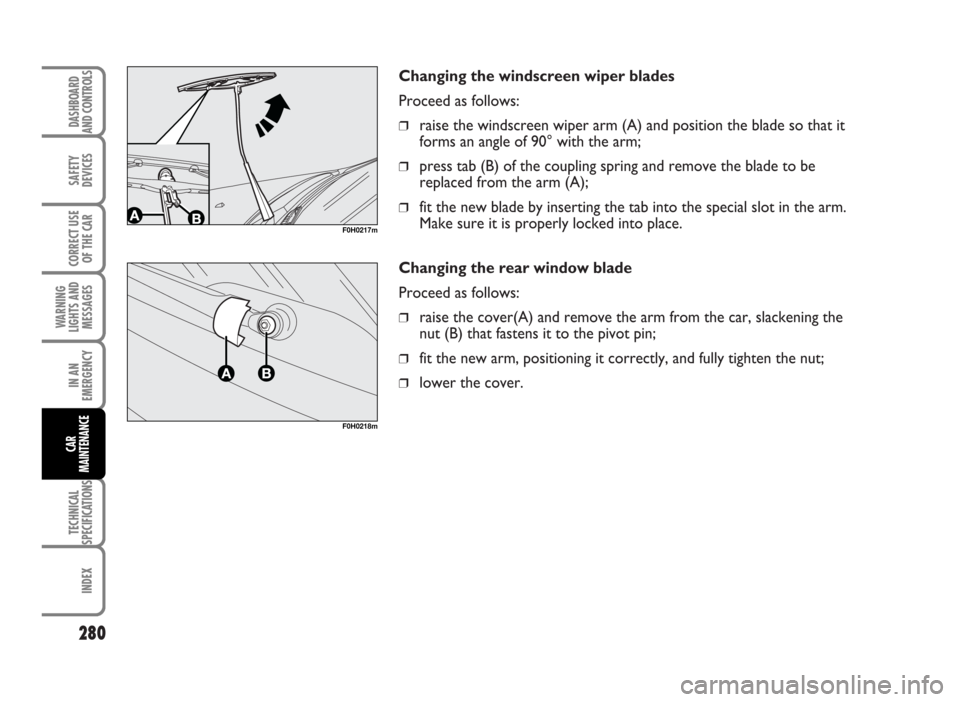
Changing the windscreen wiper blades
Proceed as follows:
❒raise the windscreen wiper arm (A) and position the blade so that it
forms an angle of 90° with the arm;
❒press tab (B) of the coupling spring and remove the blade to be
replaced from the arm (A);
❒fit the new blade by inserting the tab into the special slot in the arm.
Make sure it is properly locked into place.
Changing the rear window blade
Proceed as follows:
❒raise the cover(A) and remove the arm from the car, slackening the
nut (B) that fastens it to the pivot pin;
❒fit the new arm, positioning it correctly, and fully tighten the nut;
❒lower the cover.
280
SAFETY
DEVICES
CORRECT USE
OF THE CAR
WARNING
LIGHTS AND
MESSAGES
IN AN
EMERGENCY
TECHNICAL
SPECIFICATIONS
INDEX
DASHBOARD
AND CONTROLS
CAR
MAINTENANCE
F0H0217m
F0H0218m
Page 282 of 314
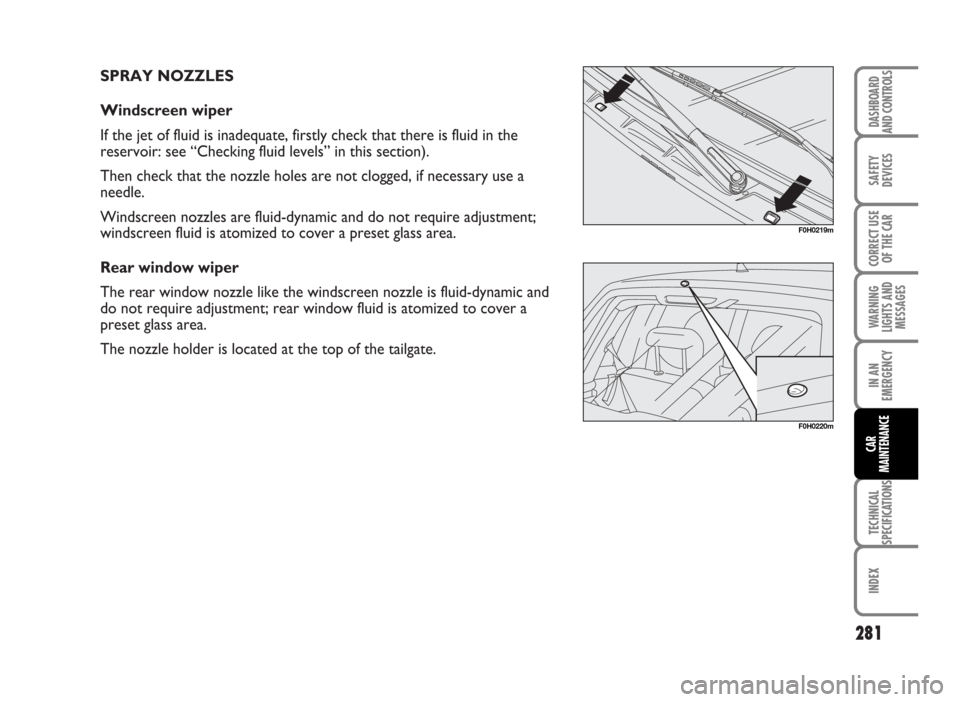
SPRAY NOZZLES
Windscreen wiper
If the jet of fluid is inadequate, firstly check that there is fluid in the
reservoir: see “Checking fluid levels” in this section).
Then check that the nozzle holes are not clogged, if necessary use a
needle.
Windscreen nozzles are fluid-dynamic and do not require adjustment;
windscreen fluid is atomized to cover a preset glass area.
Rear window wiper
The rear window nozzle like the windscreen nozzle is fluid-dynamic and
do not require adjustment; rear window fluid is atomized to cover a
preset glass area.
The nozzle holder is located at the top of the tailgate.
281
SAFETY
DEVICES
CORRECT USE
OF THE CAR
WARNING
LIGHTS AND
MESSAGES
IN AN
EMERGENCY
TECHNICAL
SPECIFICATIONS
INDEX
DASHBOARD
AND CONTROLS
CAR
MAINTENANCE
F0H0219m
F0H0220m
Page 283 of 314

282
SAFETY
DEVICES
CORRECT USE
OF THE CAR
WARNING
LIGHTS AND
MESSAGES
IN AN
EMERGENCY
TECHNICAL
SPECIFICATIONS
INDEX
DASHBOARD
AND CONTROLS
CAR
MAINTENANCE
BODYWORK
PROTECTION FROM ATMOSPHERIC
AGENTS
The main causes of corrosion are the following:
❒atmospheric pollution;
❒salty air and humidity (coastal areas, or hot humid
climates);
❒seasonal environment conditions.
Not to be underestimated is also the abrasive action
of wind-borne atmospheric dust and sand and mud and
gravel raised by other vehicles.
On your Fiat Idea, Fiat implemented the best
manufacturing technologies to effectively protect the
bodywork against corrosion.
These include:
❒Painting products and systems which give the car
particular resistance to corrosion and abrasion;
❒Use of galvanised (or pretreated) steel sheets, with
high resistance to corrosion;
❒Spraying of plastic parts, with a protective function,
in the more exposed points: underdoor, inner
fender parts, edges, etc.;
❒Use of “open” boxed sections to prevent
condensation and pockets of moisture from
triggering rust inside.BODY AND UNDERBODY
WARRANTY
Your Fiat Idea is covered by warranty against
perforation due to rust of any original element of the
structure or body. For the general terms of this
warranty, refer to “FIAT WARRANTY” booklet.
ADVICE FOR PRESERVING THE
BODYWORK
Paint
Paintwork does not only serve an aestethic purpose,
but also protects the underlying sheet metal.
In the case of deep scrapes or scores, you are advised
to have the necessary touching up carried out
immediately to avoid the formation of rust. Use only
original paint products for touching up (see
“Bodywork paint identification plate” in section
“Technical specification”).
Normal paint maintenance consists in washing at
intervals depending on the conditions and environment
of use. For example, in highly polluted areas, or if the
roads are sprayed with salt, it is wise to wash the car
more frequently.
To correctly wash the car:
❒remove the aerial from the roof to prevent damage
to it if the car is washed in an automatic system;
❒wash the body using a low pressure jet of water;
Page 284 of 314
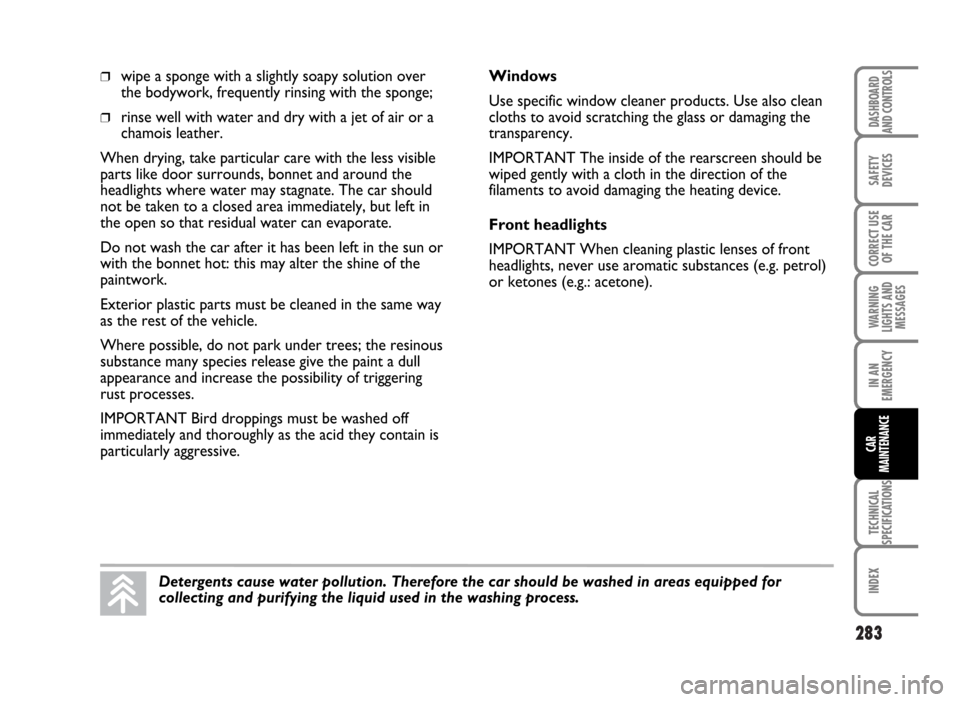
283
SAFETY
DEVICES
CORRECT USE
OF THE CAR
WARNING
LIGHTS AND
MESSAGES
IN AN
EMERGENCY
TECHNICAL
SPECIFICATIONS
INDEX
DASHBOARD
AND CONTROLS
CAR
MAINTENANCE
❒wipe a sponge with a slightly soapy solution over
the bodywork, frequently rinsing with the sponge;
❒rinse well with water and dry with a jet of air or a
chamois leather.
When drying, take particular care with the less visible
parts like door surrounds, bonnet and around the
headlights where water may stagnate. The car should
not be taken to a closed area immediately, but left in
the open so that residual water can evaporate.
Do not wash the car after it has been left in the sun or
with the bonnet hot: this may alter the shine of the
paintwork.
Exterior plastic parts must be cleaned in the same way
as the rest of the vehicle.
Where possible, do not park under trees; the resinous
substance many species release give the paint a dull
appearance and increase the possibility of triggering
rust processes.
IMPORTANT Bird droppings must be washed off
immediately and thoroughly as the acid they contain is
particularly aggressive.Windows
Use specific window cleaner products. Use also clean
cloths to avoid scratching the glass or damaging the
transparency.
IMPORTANT The inside of the rearscreen should be
wiped gently with a cloth in the direction of the
filaments to avoid damaging the heating device.
Front headlights
IMPORTANT When cleaning plastic lenses of front
headlights, never use aromatic substances (e.g. petrol)
or ketones (e.g.: acetone).
Detergents cause water pollution. Therefore the car should be washed in areas equipped for
collecting and purifying the liquid used in the washing process.
Page 285 of 314
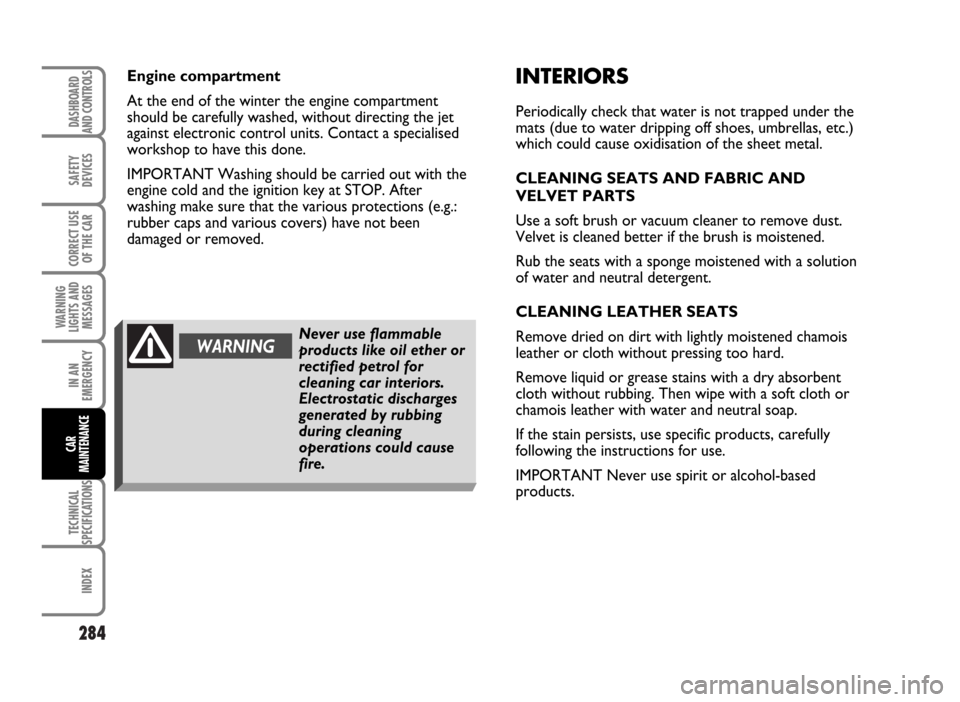
284
SAFETY
DEVICES
CORRECT USE
OF THE CAR
WARNING
LIGHTS AND
MESSAGES
IN AN
EMERGENCY
TECHNICAL
SPECIFICATIONS
INDEX
DASHBOARD
AND CONTROLS
CAR
MAINTENANCE
Engine compartment
At the end of the winter the engine compartment
should be carefully washed, without directing the jet
against electronic control units. Contact a specialised
workshop to have this done.
IMPORTANT Washing should be carried out with the
engine cold and the ignition key at STOP. After
washing make sure that the various protections (e.g.:
rubber caps and various covers) have not been
damaged or removed.INTERIORS
Periodically check that water is not trapped under the
mats (due to water dripping off shoes, umbrellas, etc.)
which could cause oxidisation of the sheet metal.
CLEANING SEATS AND FABRIC AND
VELVET PARTS
Use a soft brush or vacuum cleaner to remove dust.
Velvet is cleaned better if the brush is moistened.
Rub the seats with a sponge moistened with a solution
of water and neutral detergent.
CLEANING LEATHER SEATS
Remove dried on dirt with lightly moistened chamois
leather or cloth without pressing too hard.
Remove liquid or grease stains with a dry absorbent
cloth without rubbing. Then wipe with a soft cloth or
chamois leather with water and neutral soap.
If the stain persists, use specific products, carefully
following the instructions for use.
IMPORTANT Never use spirit or alcohol-based
products.
WARNINGNever use flammable
products like oil ether or
rectified petrol for
cleaning car interiors.
Electrostatic discharges
generated by rubbing
during cleaning
operations could cause
fire.
Page 286 of 314

285
SAFETY
DEVICES
CORRECT USE
OF THE CAR
WARNING
LIGHTS AND
MESSAGES
IN AN
EMERGENCY
TECHNICAL
SPECIFICATIONS
INDEX
DASHBOARD
AND CONTROLS
CAR
MAINTENANCE
Upholstery of your car has been designed
to withstand wear deriving from common
use of the car. You are however
recommended to avoid strong and/or
continuous scratching with clothing
accessories such as metallic buckles, studs,
Velcro fastenings and the like, since these
items cause circumscribed stress of the
cover fabric that could lead to yarn
breaking, and damage the cover as a
consequence.
INTERIOR PLASTIC PARTS
For routine cleaning, wipe with a cloth with water and
neutral non-abrasive detergent. Remove grease or
persistent stains with appropriate products designed
to preserve the appearance of components.
IMPORTANT Never use spirit or petroleum to clean
the instrument panel or other plastic parts.STEERING WHEEL / GEARBOX LEVER
KNOB AND SEATS COATED WITH REAL
LEATHER
These components shall only be cleaned with water
and neutral soap. Never use spirit or alcohol-based
products.
Before using special products for cleaning interiors,
read carefully label instructions and indications to
make sure they are free from spirit and/or alcohol-
based substances.
If when cleaning the windscreen with special glass
products, some drops fall on the leather covering of
the steering wheel/gear lever knob remove them
immediately and then clean with water and neutral
soap.
IMPORTANT Take the utmost care when engaging
the steering lock to prevent scratching the leather
covering.
WARNINGDo not keep aerosol cans in the car: they might explode. Aerosol cans must never
be exposed to a temperature above 50°C. The temperature inside the car exposed
to the sun may go well beyond that figure.
Page 287 of 314
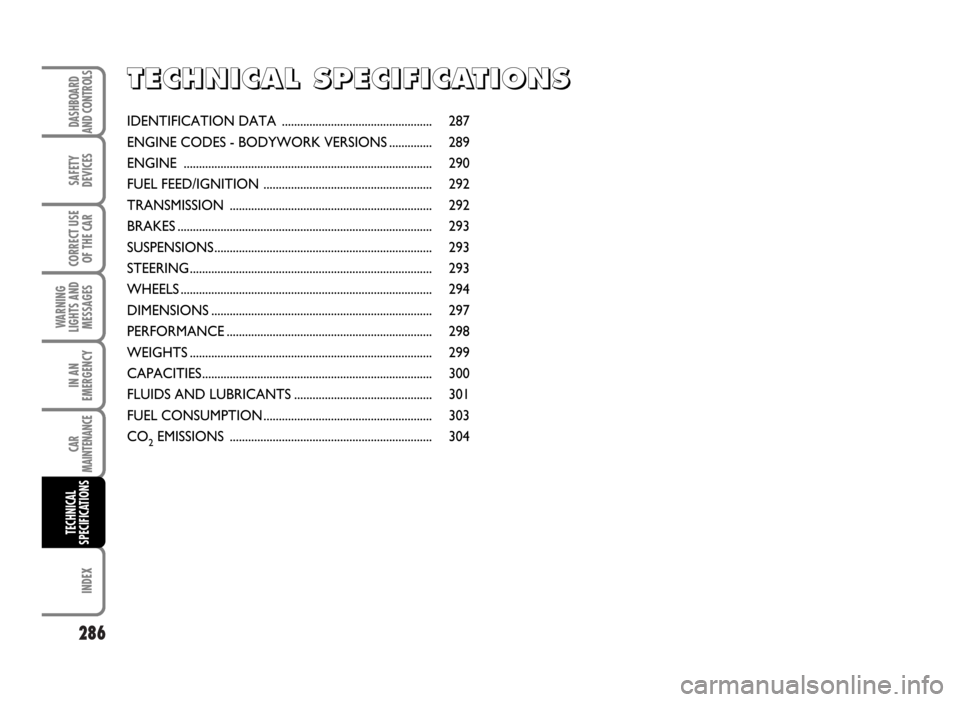
286
SAFETY
DEVICES
CORRECT USE
OF THE CAR
WARNING
LIGHTS AND
MESSAGES
IN AN
EMERGENCY
CAR
MAINTENANCE
INDEX
DASHBOARD
AND CONTROLS
TECHNICAL
SPECIFICATIONS
T T
E E
C C
H H
N N
I I
C C
A A
L L
S S
P P
E E
C C
I I
F F
I I
C C
A A
T T
I I
O O
N N
S S
IDENTIFICATION DATA ................................................. 287
ENGINE CODES - BODYWORK VERSIONS .............. 289
ENGINE ................................................................................. 290
FUEL FEED/IGNITION ....................................................... 292
TRANSMISSION .................................................................. 292
BRAKES ................................................................................... 293
SUSPENSIONS ....................................................................... 293
STEERING............................................................................... 293
WHEELS .................................................................................. 294
DIMENSIONS ........................................................................ 297
PERFORMANCE ................................................................... 298
WEIGHTS ............................................................................... 299
CAPACITIES........................................................................... 300
FLUIDS AND LUBRICANTS ............................................. 301
FUEL CONSUMPTION ....................................................... 303
CO
2EMISSIONS .................................................................. 304
Page 288 of 314
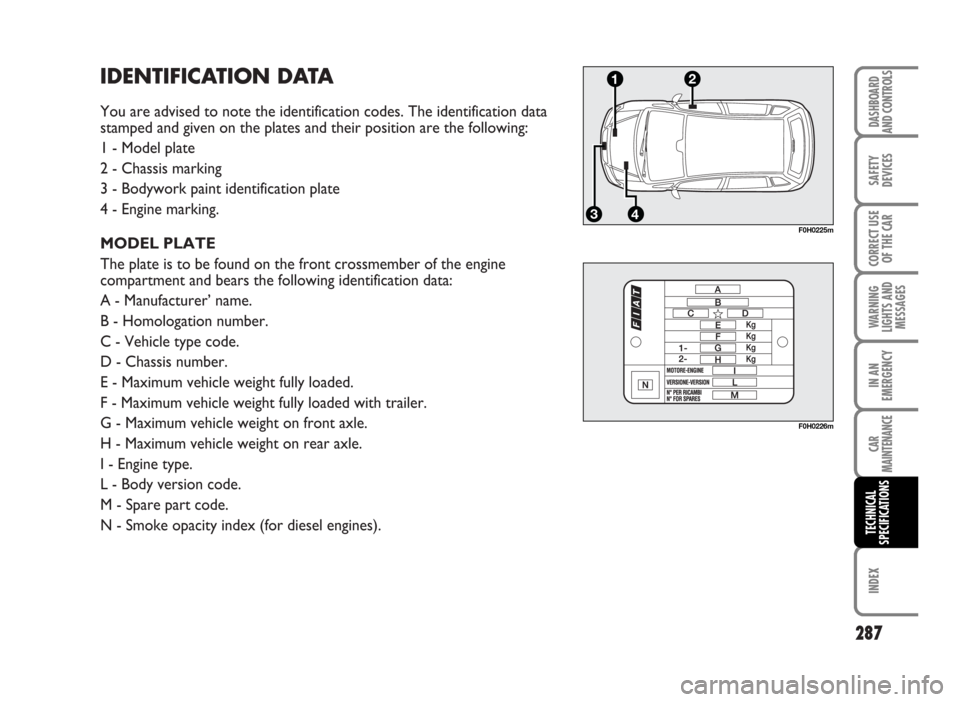
IDENTIFICATION DATA
You are advised to note the identification codes. The identification data
stamped and given on the plates and their position are the following:
1 - Model plate
2 - Chassis marking
3 - Bodywork paint identification plate
4 - Engine marking.
MODEL PLATE
The plate is to be found on the front crossmember of the engine
compartment and bears the following identification data:
A - Manufacturer’ name.
B - Homologation number.
C - Vehicle type code.
D - Chassis number.
E - Maximum vehicle weight fully loaded.
F - Maximum vehicle weight fully loaded with trailer.
G - Maximum vehicle weight on front axle.
H - Maximum vehicle weight on rear axle.
I - Engine type.
L - Body version code.
M - Spare part code.
N - Smoke opacity index (for diesel engines).
287
SAFETY
DEVICES
CORRECT USE
OF THE CAR
WARNING
LIGHTS AND
MESSAGES
IN AN
EMERGENCY
CAR
MAINTENANCE
INDEX
DASHBOARD
AND CONTROLS
TECHNICAL
SPECIFICATIONS
4
21
3F0H0225m
F0H0226m
Page 289 of 314
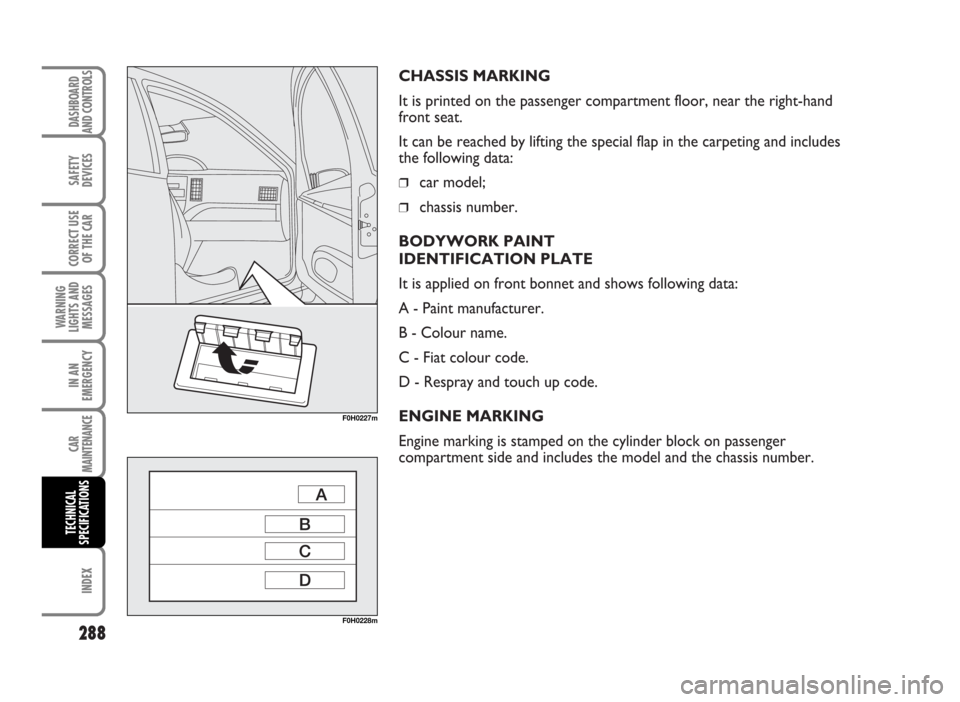
CHASSIS MARKING
It is printed on the passenger compartment floor, near the right-hand
front seat.
It can be reached by lifting the special flap in the carpeting and includes
the following data:
❒car model;
❒chassis number.
BODYWORK PAINT
IDENTIFICATION PLATE
It is applied on front bonnet and shows following data:
A - Paint manufacturer.
B - Colour name.
C - Fiat colour code.
D - Respray and touch up code.
ENGINE MARKING
Engine marking is stamped on the cylinder block on passenger
compartment side and includes the model and the chassis number.
288
SAFETY
DEVICES
CORRECT USE
OF THE CAR
WARNING
LIGHTS AND
MESSAGES
IN AN
EMERGENCY
CAR
MAINTENANCE
INDEX
DASHBOARD
AND CONTROLS
TECHNICAL
SPECIFICATIONS
F0H0228m
F0H0227m
Page 290 of 314
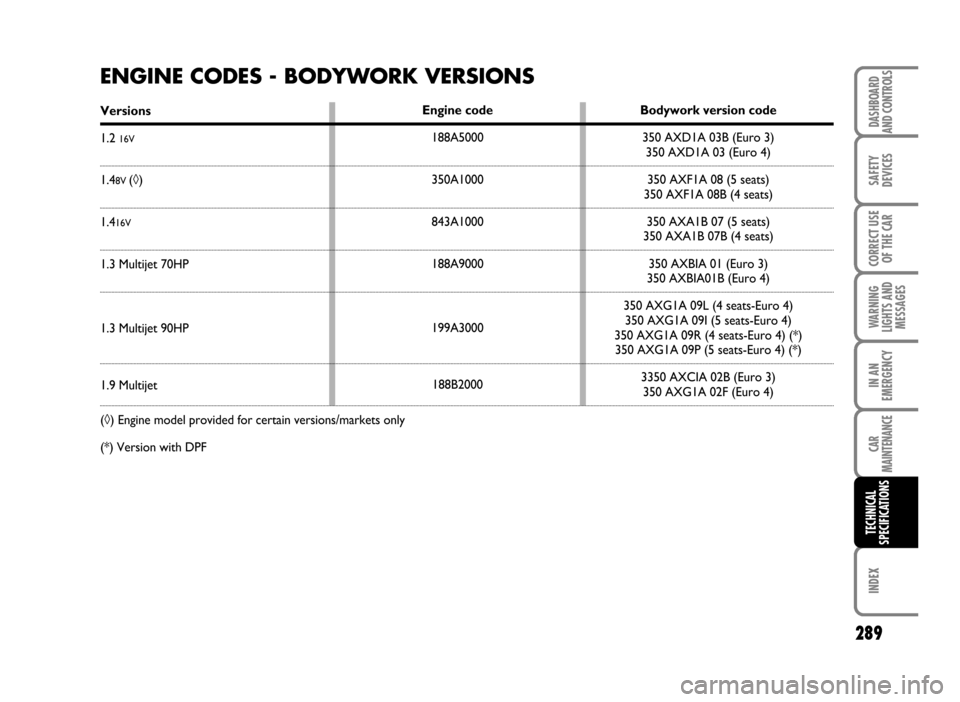
ENGINE CODES - BODYWORK VERSIONS
Versions
1.2
16V
1.48V (◊)
1.416V
1.3 Multijet 70HP
1.3 Multijet 90HP
1.9 Multijet
(◊) Engine model provided for certain versions/markets only
(*) Version with DPF
289
SAFETY
DEVICES
CORRECT USE
OF THE CAR
WARNING
LIGHTS AND
MESSAGES
IN AN
EMERGENCY
CAR
MAINTENANCE
INDEX
DASHBOARD
AND CONTROLS
TECHNICAL
SPECIFICATIONS
Engine code
188A5000
350A1000
843A1000
188A9000
199A3000
188B2000Bodywork version code
350 AXD1A 03B (Euro 3)
350 AXD1A 03 (Euro 4)
350 AXF1A 08 (5 seats)
350 AXF1A 08B (4 seats)
350 AXA1B 07 (5 seats)
350 AXA1B 07B (4 seats)
350 AXBIA 01 (Euro 3)
350 AXBIA01B (Euro 4)
350 AXG1A 09L (4 seats-Euro 4)
350 AXG1A 09I (5 seats-Euro 4)
350 AXG1A 09R (4 seats-Euro 4) (*)
350 AXG1A 09P (5 seats-Euro 4) (*)
3350 AXCIA 02B (Euro 3)
350 AXG1A 02F (Euro 4)